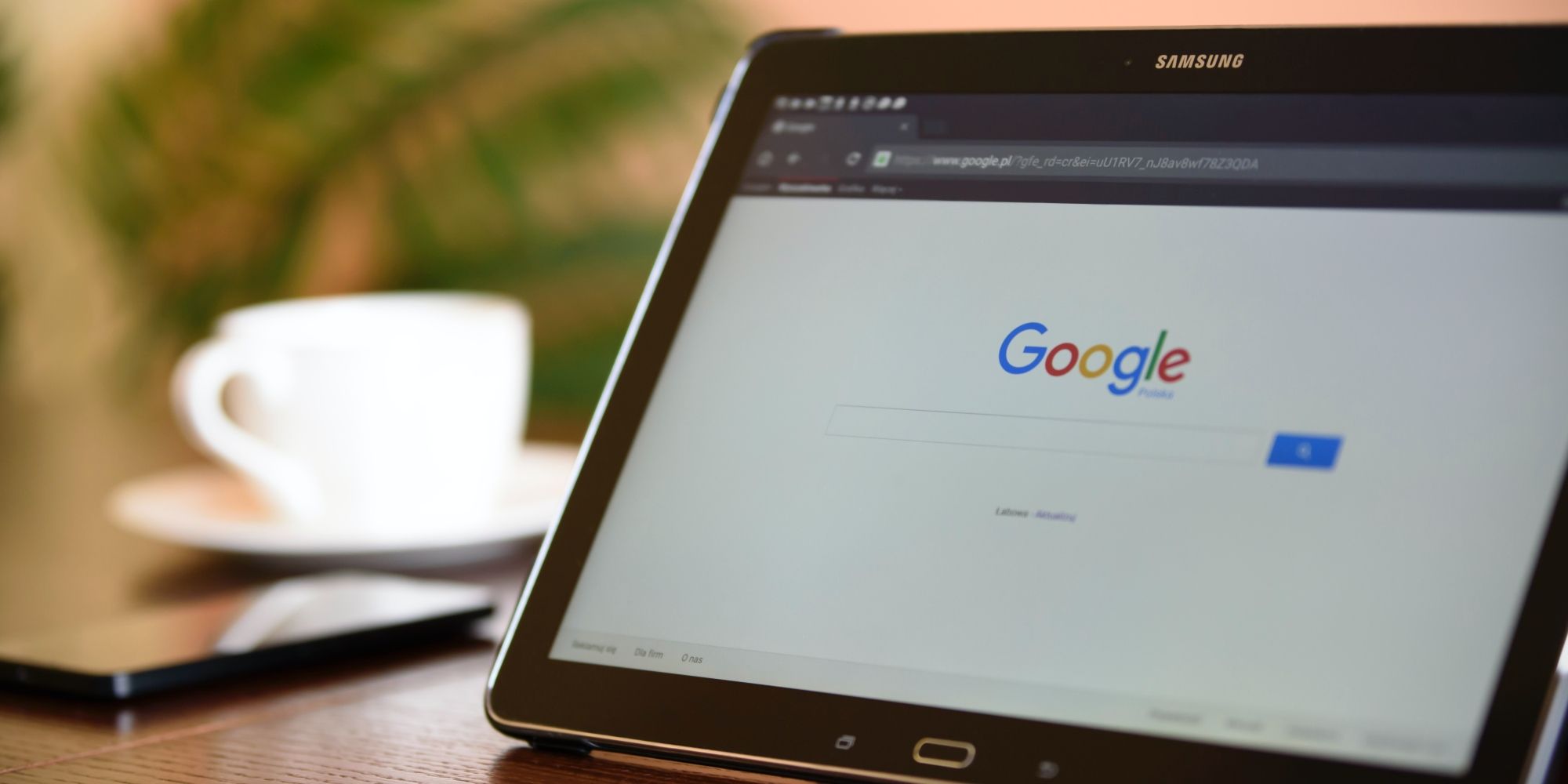The 10 Best Touchscreen Laptops (Updated 2023)
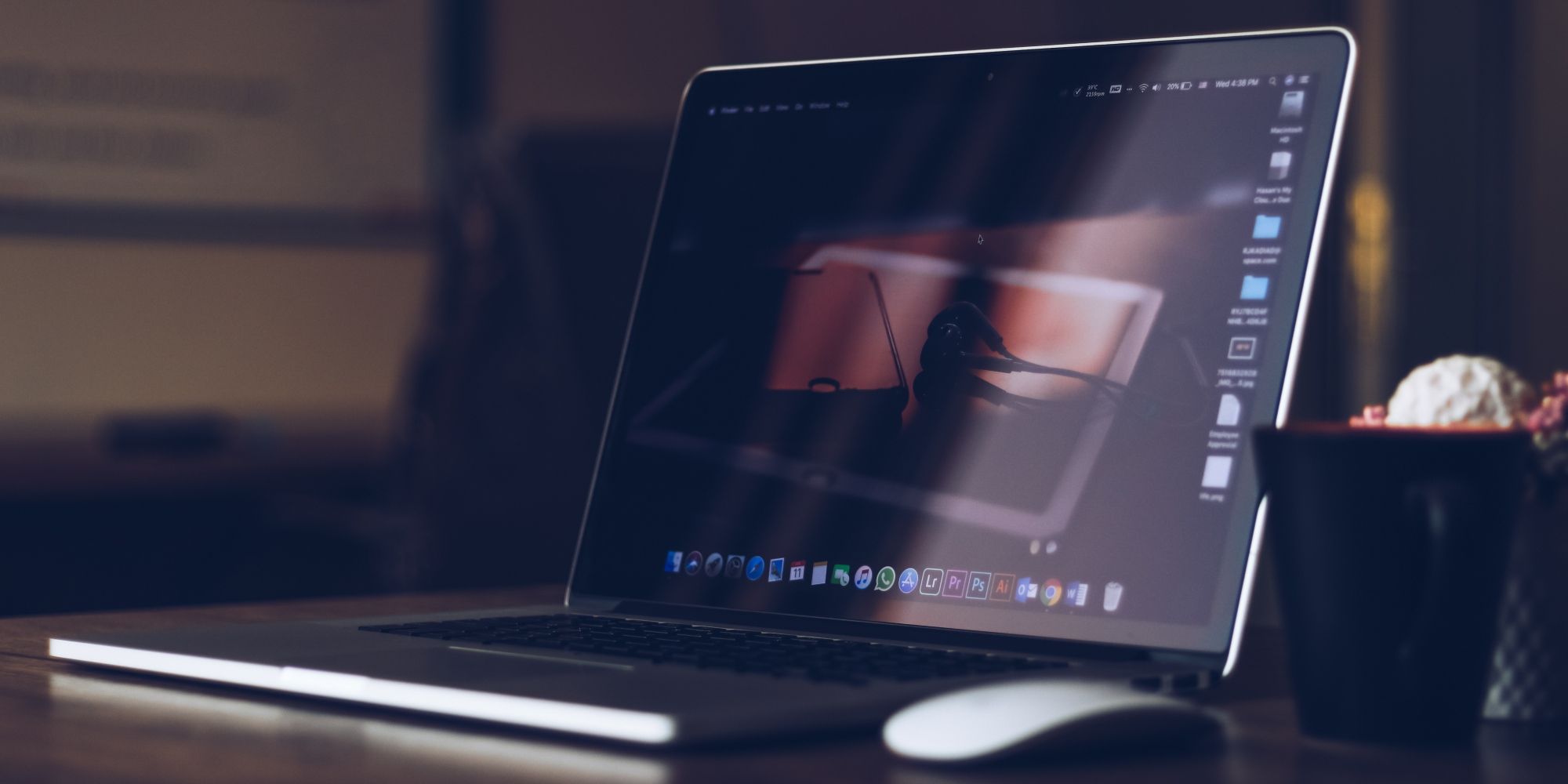
Summary List
We live in a touchscreen world. Thanks to the ubiquitous cellphone, we all are used to interacting with our technology by merely using our fingers. Whether that’s a favorable development is an argument for another forum, but it is unmistakable that touchscreen technology is here to stay. So, it is no surprise that the best laptops also feature touchscreens And, there is no need to discuss the usefulness of a touchscreen on a laptop; they are here to stay. The only question is whether you need one or not.
Touchscreen technology has come a long way such that it has become commonplace on both low-end and flagship models of laptops; it is no longer a perk that goes along with a high price. And, thanks to the rise of Chromebooks, Windows is not the only touchscreen operating system to tap your fingers on a laptop. And, what we like as consumers is choice, and that is definitely the case today with the plethora of touchscreen laptop choices.
The days when laptops were considered significantly less powerful than their elder cousin desktop computers are long gone. Now, thanks to shrink-ray technology, essentially the same components found in desktops are now being put into smaller and smaller laptops. And there is no better example of a small and powerful touchscreen laptop that is just as powerful as a desktop than the Dell XPS 13 9310.
The power of a touchscreen laptop starts with the CPU, and the Dell XPS 13 9310 comes with a ridiculously core-packed (four as opposed to the typical two) 10th gen Intel Core i7 CPU with 32GB RAM.. That is a lot of processing power and the XPS 13 7390 lives up to it with a lightning-fast performance that will satisfy any power user. The anti-glare, 13.4-inch display is a sharp and precise touchscreen panel. The touchscreen is responsive but can be a little slow, and the Dell Active Pen is not included. The keyboard has good travel though it may feel cramped to some users. Connectivity is somewhat sparse with two USB-C Thunderbolt 3 ports and a microSD card reader. The speed and power of the Dell XPS 13 9310 are packed into an aluminum body, and it has a dense feeling, which is a testament to the build quality.
A four-core CPU may seem like overkill for a 13.4-inch, 2-in-1 convertible laptop, but that power allows the XPS to be a small form, productivity powerhouse. Though it can be pricey, it is a powerful choice as a touchscreen laptop.
- 1 TB hard disk size
- 3456 x 2160 screen resolution
- Infinity Edge display
- Lightweight and slim
- Dell quality
- Backlit keyboard
- Only 4 ports
- Short battery life

Today’s technology is good at giving us things we didn’t know we needed or wanted. Sure, a Wi-Fi connected washing machine is weird, but it is cool. When you think of laptops, dual-screen doesn’t come to mind. The compact design doesn’t seem to lend itself to what is a typical feature or capability of a desktop computer. The Asus ZenBook Pro Duo comes along to tell us we need a dual-screen laptop.
Featuring a 12th gen Intel Core i9 CPU, the ZenBook Pro Duo has 32GB RAM and 2TB storage. It also has discrete graphics in the NVIDIA GeForce RTX 3060 GPU. The display setup of the ZenBook Pro Duo is where the magic happens. The main display is a 15.6 inch, 4K OLED. But, not stopping there, the ZenBook Pro Duo also features a second screen built into the body of the laptop. Dubbed ScreenPad Plus by Asus, it is a 14 inch, 4K display and can be used to either extend the main screen or split windows and apps on both displays, truly a multitasker’s dream. Both screens have excellent color quality, though items can seem a bit cramped going from the main screen to the secondary one. Both panels are touchscreen, and the Asus Stylus pen is included.
Innovation can come at a cost, and here that cost (along with the actual cost) is the weight of the ZenBook Pro Duo. It is well-built with its metal casing, but it is a bit weighty and chunky at about 5.8 pounds. The keyboard is shifted down and narrowed due to the ScreenPad Plus necessitating an included, detachable palm rest. Combine this with poor battery life, and the ZenBook Pro Duo is more of an alternative desktop than a true, portable laptop.
Despite the downsides, the ZenBook Pro Duo is a fast performing machine with a feature that you may not have realized you needed or wanted. Maybe dual-screen will be a standard feature on future laptops… only time will tell.
- Dual-screen with ScreenPad Plus
- Core i9 six-core CPU
- 15.6 inch 4K OLED main display
- Asus stylus pen included
- Dual-screen functionality
- Fast performance
- Alexa compatible

ASUS Zenbook Pro Duo 15 OLED 12th Gen 15.6″
Value without compromising performance that is something we all want out of whatever tech product we buy. Premium features like slim bezels, good battery life, and a great screen should not always equate to premium price. The Asus Chromebook Flip C434 is a budget touchscreen laptop but with premium features.
The Flip C434 is powered by an Intel Core m3-8100Y CPU with 4GB RAM and 64GB storage, plenty of power and storage for a Chromebook even with multiple tabs open. It features a 14 inch Full HD 1080p display with tiny bezels that give a much bigger impression. Though the brightness could be better, the screen is sharp and vivid. The touchscreen was smooth and responsive. The keyboard is backlit, and the keys have decent travel and are nicely spaced. Connectivity includes 2 USB-C ports, 1 USB-A port, and a microSD reader.
Build-quality of the Flip C434 is premium as well with its aluminum construction and solid feel. Asus boasts that the Flip C434 is a 14-inch laptop in a 13-inch footprint, and its compactness bears that out. The convertibility of the Flip C434 is highlighted by the 360 hinge that allows a smooth transition from laptop mode to tent mode, and to tablet mode. A nice feature of the hinge is that it is dual-action, meaning it slightly lifts and tilts the keyboard into optimal typing position when in laptop mode.
If you opt for Chromebooks over Windows, you can’t go wrong with the Flip C434. It offers the premium features of a touchscreen laptop, but without the premium price.
- 360 degree hinge
- Backlit keyboard
- NanoEdge display
- Solid build quality
- Snappy performance
- Good battery life
- Sleek design
- Limited to Android apps
- A little pricey
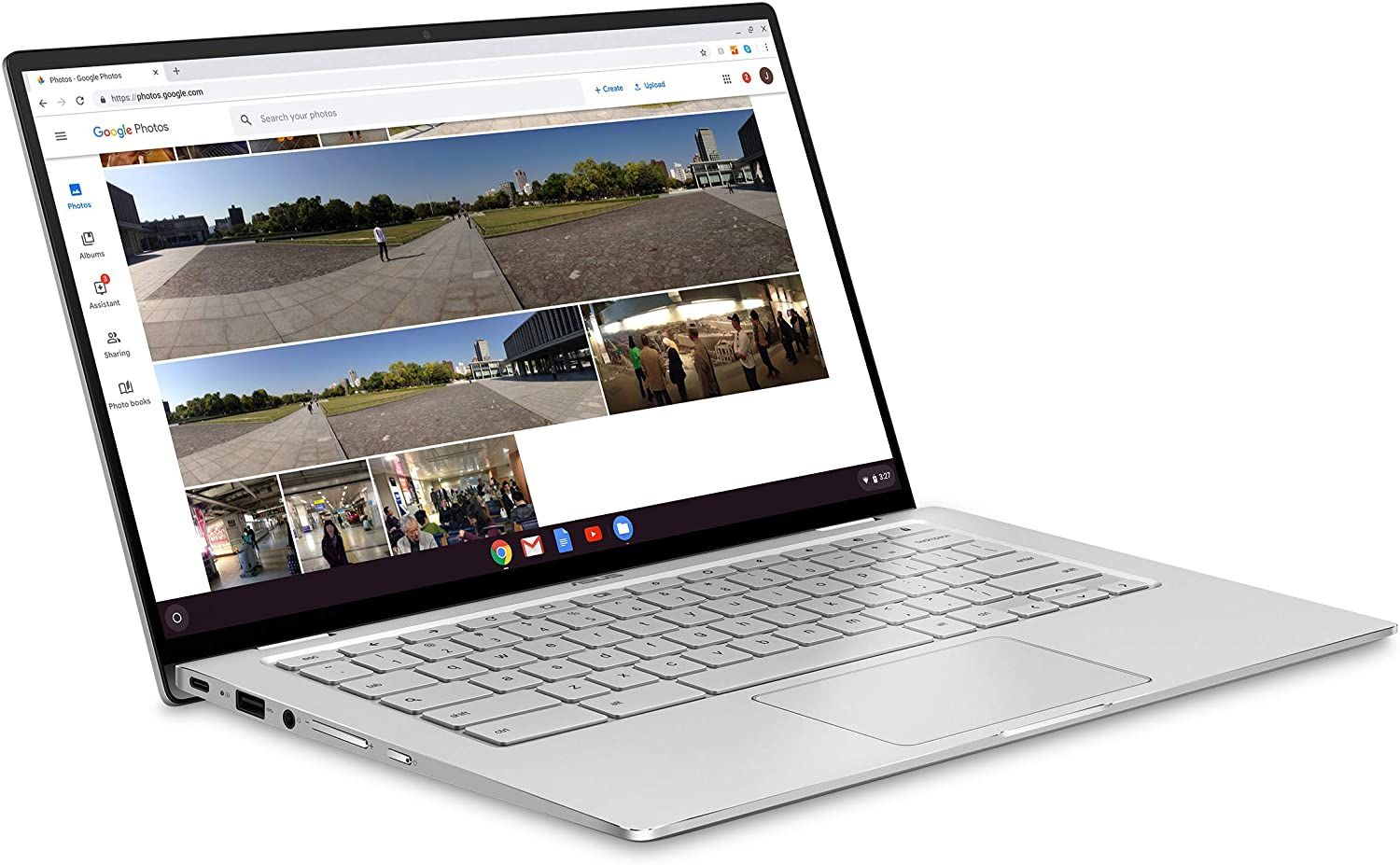
Laptops are becoming smaller and lighter, and unfortunately, that too often means some functionality is sacrificed. Notable deletions from ultra-thin laptops include no USB-A port, full-size, comfortable keyboards, battery-life, and loss of some Windows 10 functionality. HP scoffs at the idea of smaller and thinner equaling less with the Spectre x360-13t, which packs a surprising amount of features into a sizably small laptop.
The x360-13t is a convertible 2 in 1 laptop with an Intel 10th gen quad-core Core i7-1065G7 CPU, 16GB RAM, 1TB of storage (replaceable M.2 SSD), and a 13.3 inch, 4K AMOLED display panel. Despite the display losing much of the bezel from the previous x360 generation, the x360 has a ridiculously small camera at the top of the display that can take advantage of the security of Windows Hello. The keyboard has a comfortable, more tactile feel with the increased travel in the keys. The x360-13t also comes with an HP claimed 22 hours of battery life, something certainly not expected out of today’s ever-shrinking laptops, especially ones with touchscreens. And speaking of touchscreens, x360-13t’s is quick and responsive. As a bonus, the x360-13t comes with the HP Stylus Pen, which is great for more precise use of the touchscreen.
Some of the few shortcomings of the x360-13t include the 16:9 resolution, which is seemingly dated with displays increasingly coming in at 16:10 and the typical HP bloatware. However, these should not detract from what is an excellent touchscreen laptop.
- 10th Generation Intel Core i7 CPU
- HP Stylus Pen
- Front-facing camera with Windows Hello
- Leather case included
- Large travel distance keyboard
- Tiny bezels
- Long battery life

Not everyone needs a touchscreen laptop with every high-end feature available. For most of us, we use our laptops for everyday tasks like web surfing, music or video playback, and using online tools and services. The Microsoft Surface Go may not feature all the performance bells and whistles of other touchscreen options, but it nevertheless is a very capable touchscreen laptop. Much like the Microsoft Surface Pro, the Surface Go is first and foremost a tablet, but it also functions just fine as a laptop.
The Surface Go is a smaller version of the Surface Pro. And with that decrease in size, comes a decrease in what’s packed inside. The Surface Go features an Intel Pentium Gold 4415Y CPU with 8 GB RAM and 128GB SSD storage. The well-built Surface Go is highlighted by a 10 inch, crisp 3:2 aspect ratio display. The touchscreen is responsive, whether scrolling or pinching-to-zoom. With the smaller screen, there can be some difficulty in touching some icons as they are tiny. The connectivity is good with features that some tablets don’t include, like a USB-C 3.1 port, MicroSDXC card reader, Surface Connect port, and a headset jack. The keyboard for the Surface Go may be a bit cramped, but it is backlit and comfortable to use. However, as is typical of Microsoft, the keyboard has to be purchased separately. The same downside applies to the Surface Pen, which does add more functionality to the Surface Go as a laptop.
With the lower tech specs, the Surface Go may not be a performance screamer, but it knows its place well. Probably the best feature of the Surface Go is the price, it is quite a bit cheaper than other touchscreen options, whether 2 in 1 or not. For what it can be used for, typical everyday use, the Surface Go makes sense as a touchscreen laptop.
- 10 inch PixelSense display
- Well-built design
- Windows 10 S Mode
- Very portable
- Affordable
- Supports Windows Hello
- Versatile kickstand
- Keyboard is a separate purchase
- No USB-A
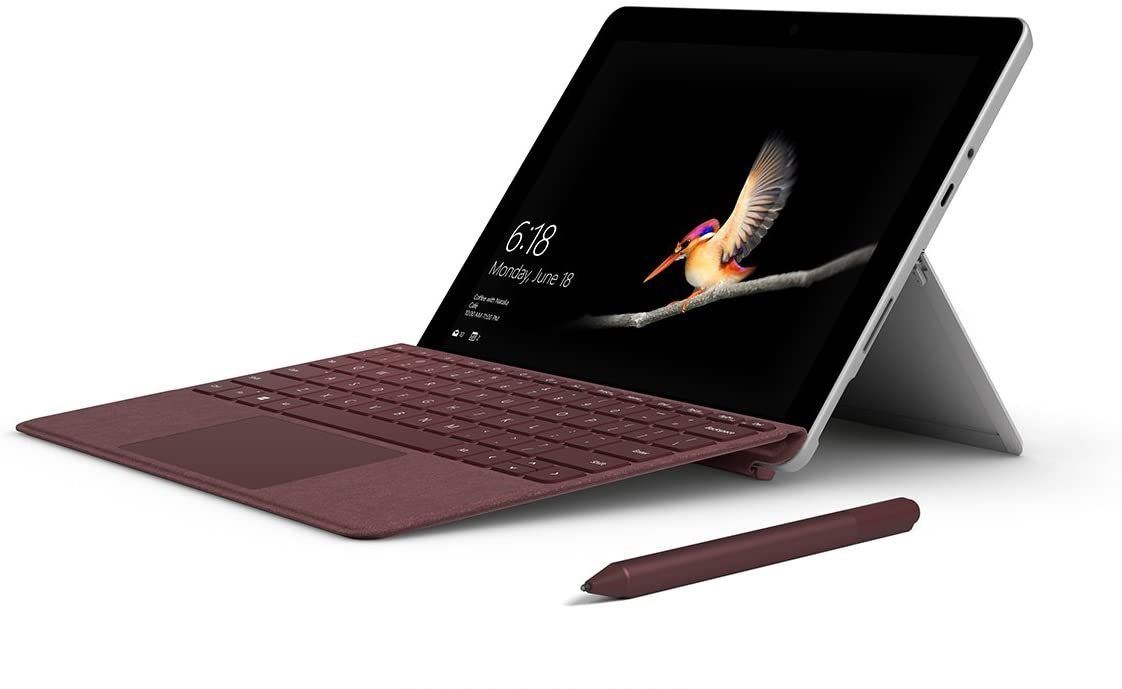
If you’re going to put one of the smallest measurements into the name of your touchscreen laptop, you have a lot of expectations to live up to. Not only does LG live up to weight expectations, but it also delivers a very capable touchscreen laptop in the LG Gram.
Coming in at only 2.5 pounds, the Gram is the epitome of lightweight. But, don’t be fooled, the Gram packs a lot in a light frame. It has a 12th Gen Intel Core i5 and 16GB RAM. The Gram has a bold and crisp 15.6 inch IPS touchscreen display, which looks even bigger thanks to the minuscule bezels. The touchscreen is responsive and accurate. The keyboard is comfortable to use with good key travel and spacing between letters. Connectivity includes three USB-A ports, HDMI, a USB-C port with Thunderbolt 3, a MicroSD slot, and a 3.5 mm headphone jack. Battery life is impressive at a claimed 21 hours from the 80Wh lithium battery. It is incredible all that tech fits in such a small and light body. LG claims the Gram has military-grade durability even though the lightness and feel of the Gram belies the claim. Durability claims aside, the good build quality of the Gram can certainly withstand typical, day to day use.
The LG Gram is a solid performer as a touchscreen laptop. If one of your main requirements out of a touchscreen laptop is that it is lightweight, you can’t go wrong with the Gram. Just be prepared for that preference to be an expensive one.
- 15.6 inch full HD display
- Ultra-slim and ultra-light
- Long battery life
- Thunderbolt 3
- Fingerprint reader embedded into power button
- 1TB internal storage
- Webcam placed above screen

Many times, the alternative (i.e., lower-priced) version of a model can mean having to settle for far less than the premium edition. When it comes to laptops, that can mean doing without quality build materials, slower performance, reduced functionality, and the like. The Google Pixelbook Go eschews that line of thought and presents itself as an alternative just as capable as its elder siblings.
The Pixelbook Go is the entry-level model of the Pixelbook Go line and comes with the easy-to-use Chrome OS, and 128 GB of hard disk storage. Those specs may not seem very impressive, but considering Chrome OS does not use huge amounts of RAM, it is more than adequate for peppy performance on the Pixelbook Go M3. Connectivity consists of two USB-C ports that can handle charging and display output and a 3.5 mm headphone jack.
The 13.3-inch screen of the Pixelbook Go is a vibrant 16:9 aspect ratio, 1080p display. The touchscreen is responsive, and using it is familiar if you are used to the touchscreen on Android phones. Unfortunately, the display does not support using a stylus. The backlit keyboard on the Pixelbook Go is a highlight and routinely lauded as one of the best keyboards on a laptop. The keyboard features a combination of silence and feedback culminating in a comfortable, use-all-day feel. And amazing for any laptop at any price, the Pixelbook Go has a 1080p front-facing camera.
The performance, build quality, and feature set of the Pixelbook Go are on par with similar touchscreen Chromebooks. The Pixelbook Go may not be top of the line spec-wise, but it is a great and useful choice as a touchscreen laptop.
- Impressive battery life
- Solid build quality
- Excellent keyboard
- Great for on the go use
- No fingerprint scanner
- No Pixelbook Pen support
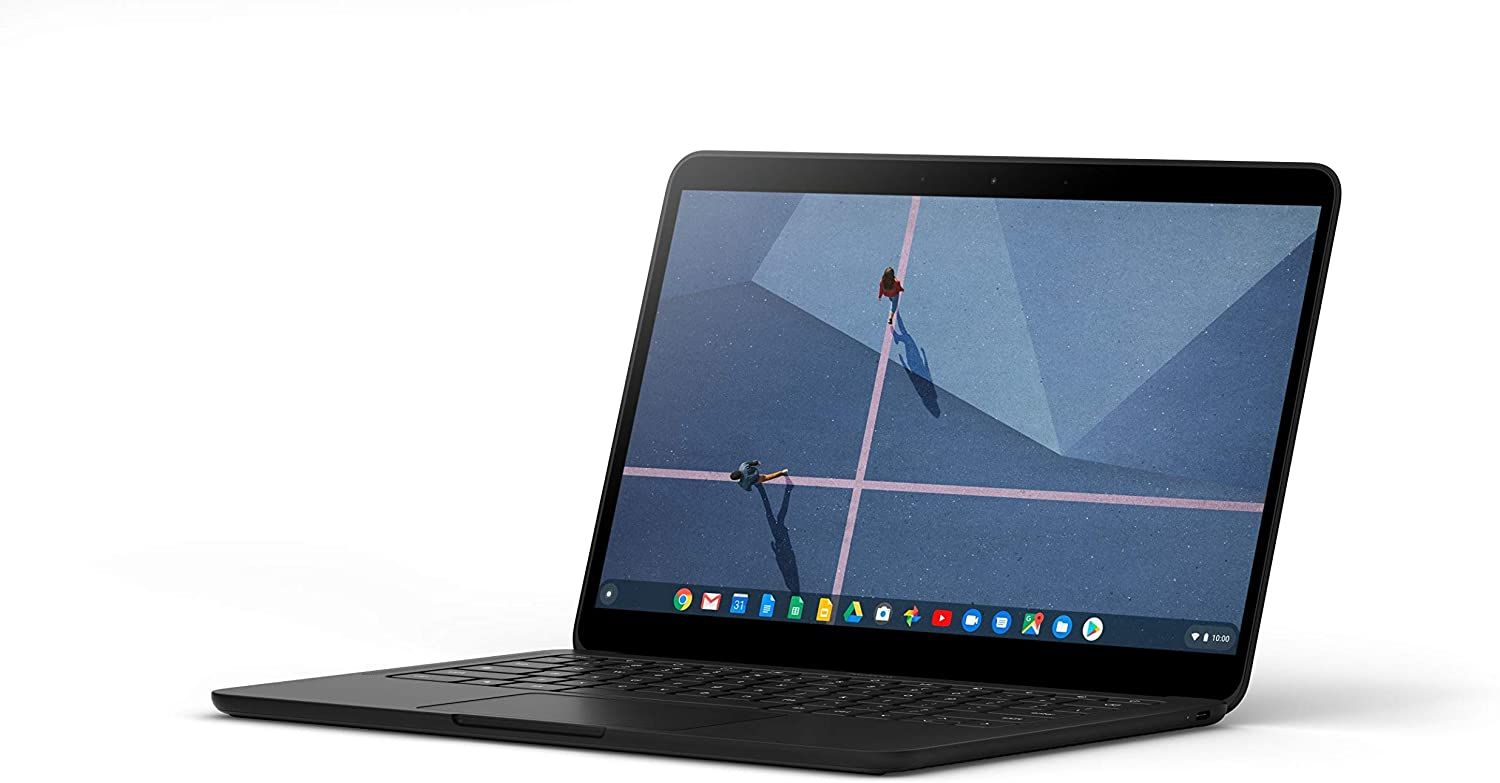
The inclusion of a touchscreen usually means a higher price when it comes to laptops. Adding in a touchscreen to a 2-in-1 can make the price even higher. The Lenovo 2022 Flex 5 14 is a 2-in-1 with a touchscreen that breaks the high-price mold proving that affordability is not a death knell for a feature-packed, solid performing touchscreen laptop.
When one thinks of laptop processors, it usually comes to mind first, but AMD is also a player in the field. The Flex 5 14 is packed with an eight-core, eight-thread AMD Ryzen 7-3700U CPU. The result is a touchscreen laptop with snappy performance. Storage is a 512 GB SSD, and the large-ish, 14-inch colorful display is 1080p and powered by Integrated AMD Radeon Graphics. The touchscreen is smooth and precise. The touchscreen also supports the Lenovo Active Pen 2.
“Flex” is certainly an appropriate name for this touchscreen laptop as the 360-degree hinge makes converting from laptop to tablet quick and easy. Though it may be slightly heavier than comparable models, the Flex 5 14 is still lightweight and portable at just over 3.5 pounds inside its thin chassis. A large and responsive touchpad accompanies the slightly cupped, good travel keyboard keys.
Even with its thin bezels, the Flex is not as flashy as competing touchscreen laptops. Also, the battery life leaves something to be desired. The Flex 5 14 is a fast performer and a solid alternative as a touchscreen laptop.
- 360 degree rotating screen
- AMD Ryzen 7-5700U CPU
- Integrated Radeon Graphics
- Affordable
- Webcam TrueBlock privacy shutter
- Backlit keyboard
- Fast perfomance
- Display is somewhat dim
- Digital pen sold separately

Lenovo 2022 Flex 5 14” 2-in-1 2K Touchscreen Laptop
As with most tech gadgets, there are mid-range options for touchscreen laptops. What usually happens with mid-range is that some features of the higher-end options are sacrificed to attain the lower price. The Acer Spin 514 is a mid-range touchscreen laptop that demonstrates mid-range sacrifices don’t necessarily mean lower performance.
A convertible 2-in-1, the Spin 514 is powered by a mid-range, Ryzen 3 CPU with 4GB RAM and 64GB storage. The display is expressive at 14 inches and a 16:9 aspect ratio that is ideal for videos and reading in portrait mode. The 10-finger, touch-sensitive screen is quick in responding to swipes and gestures. The unlit keyboard has short-travel and functions well. There is good connectivity with six ports, and the versatility of the Spin 514 is highlighted by the 360-degree hinge that allows for easy transition from laptop to tablet.
Performance is good, albeit mid-range. Where the mid-range tag becomes most apparent is in the build quality of the Spin 514. The build design of the Spin 514 is plastic, which makes it feel somewhat cheap. Again, mid-range more often than not means sacrifice.
Despite the build quality, the Spin 514 is a good performer as a touchscreen laptop. It has a great screen, and a mid-range price tag.
- 360 degree hinge
- 8th gen Core i5 CPU
- Rechargeable Active Stylus
- Affordable
- 2 in 1 convertible
- Large screen
- Good battery life

The category of touchscreen laptops usually includes 2-in-1 convertibles and traditional laptops, but there is another configuration that should be considered. The Microsoft Surface Pro 7 is first and foremost a tablet, but with the optional, detachable keyboard, it becomes a very capable touchscreen laptop, thereby deserving consideration here. For the sake of this review, the focus centers on Surface Pro 7 as a laptop.
Under the hood, the Surface Pro 7 sports a 10th gen Intel Core i5 CPU with 8GB of RAM. The display is a crisp 12.3-inch PixelSense display (2736×1824). The part that makes the Surface Pro 7 a laptop, unfortunately, has to be purchased separately. The Microsoft Type Cover is an excellent keyboard with good travel keys, backlighting, and a touchpad that tracks smoothly. The touchscreen on the Surface Pro 7 is typical of the Surface line in that it is quick and responsive. For those that want to write and doodle, there is the Surface Pen, also unfortunately not bundled with the Surface Pro 7. The built-in kickstand adds to the laptop usability of the Surface Pro 7. Unlike previous versions, the Surface Pro 7 includes a USB-C port.
The downsides of the Surface Pro 7 include the rather large bezels which may be functional for its use as a tablet, but make it look dated as a laptop. And, it doesn’t support Thunderbolt 3 for faster transfer and charging speeds. However, as a tablet that can also be a laptop, the Surface 7 Pro is a great selection as a touchscreen laptop.
- 10th gen Intel Core i5 CPU
- Slim and lightweight
- All-day battery life
- Built-in kickstand
- USB-C port
- Good performance
- Excellent keyboard
- Large bezels
- Keyboard has to be purchased separately
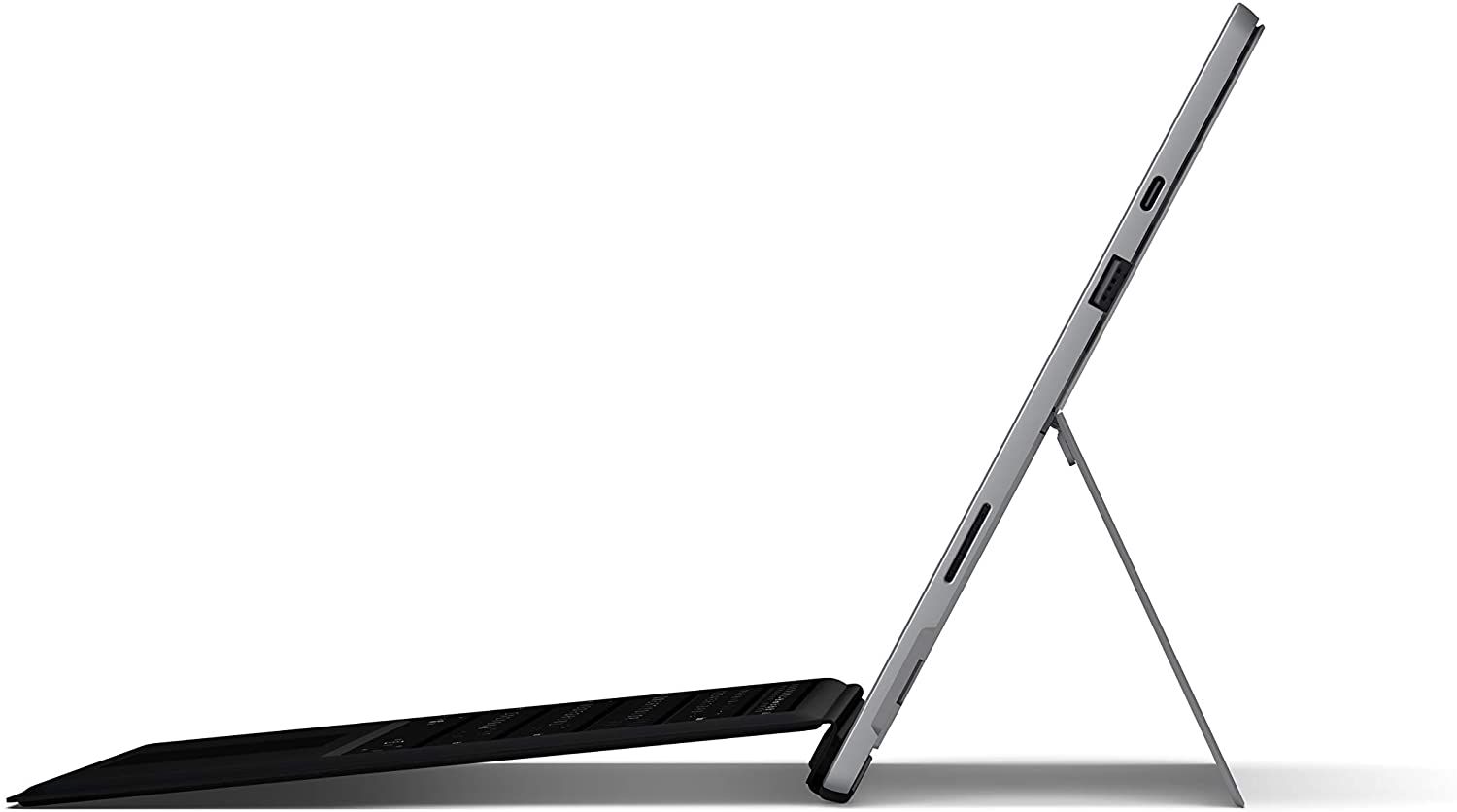
So what if having a touchscreen on a laptop is not an absolute necessity? It is definitely a nice feature on today’s laptops. And there’s no doubt that nice to have features tend to end up being hard to live without like GPS on our phones and frost-free freezers. But, not all features, especially in technology, make sense; do we really need intelligent toilets or smart juicers? But, occasionally, a new or expanded feature comes along that does make sense, and the touchscreen is just such a feature.
Pros And Cons
And with any feature, there are pros and cons. One of the main pros is that touchscreens have become very intuitive. We see them everywhere in retail shopping settings, as well as on our favorite things in the world, our cell phones. There really is no learning curve to using a touchscreen on a laptop, thanks to the cellphone, we are already primed to interact with laptops by using our fingers. Navigation is also faster using a touchscreen, say goodbye to losing track of the cursor, with touchscreens, you put the cursor exactly where you want it. And, touchscreens are great for drawing and writing. Many touchscreen laptops are compatible with stylus pens (some even come with the pen included), which adds to the versatility of touchscreens. Touchscreens also feature bright, vivid displays, something that can be quite useful with the smaller screens on laptops.
But, there are also several downsides to touchscreen laptops. Adding just about any new feature to the increasingly shrinking laptops can have the negative impact of draining the battery, the touchscreen is just such a culprit. Touchscreens can also add to the price of laptops, sometimes making initially affordable models, more pricey. Given that most touchscreens are glossy, they become pretty useless in brightly lit areas. Using screen covers can help combat brightness issues, and they are readily available and easy to use.
The 2-In-1
Pros and cons aside, I think the biggest shot that the touchscreen has provided for laptops is the evolution of the 2-in-1 convertible laptop. As noted by Ejectejecteject.com, the popularity of the tablet has waned for many reasons, and manufacturers have found a silver lining in combining the portability and convenience of the laptop and tablet with emphasis on the device as a laptop that can double as a tablet. Basically, a 2-in-1 is a traditional laptop, and tablet form factor melded into a single device, eliminating the need for multiple devices. Without touchscreens, such a development might not have happened. The traditional clamshell laptop certainly takes advantage of touchscreen technology, and the 2-in-1 provides a great, versatile option for a touchscreen laptop. Don’t forget a quality laptop stand. You’ll find the convenience of a solid and stylish laptop stand will make using your touchscreen much easier and more accessible.
So, now that touchscreen laptops are a thing, how do you decide which one is right for you? Take a look at this Best Touchscreen Laptop and become familiar with the top choices available. You might just be convinced that a touchscreen laptop is right for you.
FAQ
Q: What are the benefits of a touchscreen laptop?
If you’re thinking about switching to a touchscreen laptop, you’re probably wondering how this device measures up to a traditional laptop computer. There are many benefits of the best touchscreen laptop that set it apart from a regular laptop.
One of the main benefits of a touchscreen laptop is its convenience. Unlike a non-touch computer, a touchscreen PC allows the user to enjoy direct contact with their computer screen. This lets you accomplish any task more quickly and with minimal effort. Additionally, many touchscreen computers are more compact than traditional computers, making it easy for you to bring your laptop along with you wherever you go.
Q: How do I activate the touchscreen on my laptop?
Activating the touchscreen feature on a laptop is a unique process for each type of computer. If you have Windows 10, start by accessing the Power User menu. Once this menu is open, click on “Device Manager.” Scroll down to where it says “Human Interface Devices” and click on the arrow to the left of this option. This should cause a drop-down menu to appear. Scan the menu for the “HID-compliant touch screen” option and choose “Enable.” This will cause your laptop screen to begin functioning as a touch screen.
If you have a different type of operating system, be sure to look up the instructions for your OS. This will help ensure that the best touchscreen laptop works properly for you.
Q: How do you fix an unresponsive touchscreen?
If you’re dealing with an unresponsive touchscreen, there are several ways to address this issue. First, be sure to check that the screen has been cleaned recently. If you let grease and dirt accumulate on your touchscreen, it may prevent the laptop from functioning properly.
If your screen is perfectly clean, try rebooting the touchscreen laptop. It may seem like a simple step, but this can make all the difference in terms of getting your screen to respond to your touch. Finally, if all else fails, it may be time to troubleshoot the drivers. Head to the control panel, choose “Troubleshooting,” and then click on “Hardware and Devices.” You might then see an option to “Apply this fix.” Click on this option and follow the instructions to get your touchscreen laptop up and running again.
Q: Can you turn off touchscreen?
Just like you can easily activate touchscreen on your laptop, you can also disable this feature. To do so on a Windows 10 device, open up the Power User menu and select “Device Manager.” Keep scrolling down until you find the “Human Interface Devices” option, and click on the arrow to the left of this item. You should then see a drop-down menu appear on your screen. When this happens, look for the “HID-compliant touch screen” item and choose “Disable.” You’ll now be able to enjoy the best touchscreen laptop without the touchscreen feature, no matter what you aim to use it for.
Q: How do I clean a touchscreen laptop?
Cleaning your touchscreen laptop frequently is crucial to keeping it in good condition. While cleaning your PC, use a microfiber cloth to remove any fingerprints, dirt or smudges from the screen. It’s also a good idea to display a white background on your touchscreen before you start cleaning it. The whiter the background is, the more clearly you’ll be able to see any traces of grease or dirt that have built up on your screen.
While you clean your screen, be sure to apply minimal pressure using the microfiber cloth. This will help prevent accidental damage to the screen. Additionally, remember to swipe horizontally, vertically, or in gentle circular motions to get rid of any dirt or fingerprints.
Share this news on your Fb,Twitter and Whatsapp
NY Press News:Latest News Headlines
NY Press News||Health||New York||USA News||Technology||World NewsTimes News Network:Latest News Headlines
Times News Network||Health||New York||USA News||Technology||World News

